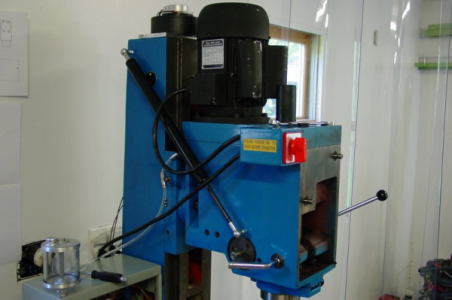I have an extra thought for your consideration, since you are replacing so much...... I long for the ability to do rigid tapping however, because the VFD - motor combination is not that precise (can be off several percent) with respect to the speed (open loop) and cannot reverse quickly (spin up and spin down delays) it does not seem to be the route to go. I think my VFD could take a speed sensor input to control the speed, but I have not investigated this as there is no easy access point on the spindle to attach a tachometer. If I were rebuilding all of your spindle drive I might want to add this feature via DC servo or stepper for the spindle motor. Yes, much more expensive. Also, my spline plus gear box have quite a bit (a couple of degrees) of backlash in them.
By the way, another consideration you may not have thought about is the weight. If you get two much weight on top, the stepper may not hold the z-axis when the power is shut off.... hence your tooling may crash into your work or table! I have observed this on my machine.
I have a (Precision Mathews) PM-940M CNC mill with a 1.5KW 3ph motor being driven by a Delta VFD. With the Mach3 software the mill was was set up for the spindle seems to run fine (it also has a poorly documented nMotion controller for the steppers, but this is separate from the spindle).
You can look up the details of the motor and VFD manual on line:
Delta Model VFD015E21. Tag says: Input: 1ph, 220-240V, 50/60Hz, 15.7A; Output: 3ph, 0-240V, 7.5A, 1-599Hz.
A quick look indicated that this model VFD is around $500, but you maybe able to find it cheaper. There is a front page photo and manual at: http://www.altonji.net/up/uploads/VFD-E.pdf Mind looks like the one on the left in the photo.
My motor looks similar in shape to the spindle motor in your photo, but maybe larger. Air cooled with a fan on top.
However, I long for the ability to do rigid tapping and and because the VFD - motor combination is not that precise on it speed (open loop) and cannot reverse quickly (spin up and spin down delays) it does not seem the route to go. I think the VFD could take a speed sensor input to control the speed, but I have not investigated this as there is no easy access point on the spindle to attach a tachometer. If I were rebuilding all of your spindle drive I might want to add this feature via DC servo or stepper for the spindle motor. Yes, much more expensive. Also, my spline plus gear box have quite a bit (a couple of degrees) of backlash in them.
By the way, I have a spare 3 phase 1.5KW Motor if you are interested. It is brand new and still in the box. You would need the VFD to convert from single phase 220 V power. It is heavy, ~40#.
By the way, another consideration you may not have thought about is the weight. If you get two much weight on top, the stepper may not hold the z-axis when the power is shut off.... hence your tooling may crash into your work or table! I have observed this on my machine.
I have a (Precision Mathews) PM-940M CNC mill with a 1.5KW 3ph motor being driven by a Delta VFD. With the Mach3 software the mill was was set up for the spindle seems to run fine (it also has a poorly documented nMotion controller for the steppers, but this is separate from the spindle).
You can look up the details of the motor and VFD manual on line:
Delta Model VFD015E21. Tag says: Input: 1ph, 220-240V, 50/60Hz, 15.7A; Output: 3ph, 0-240V, 7.5A, 1-599Hz.
A quick look indicated that this model VFD is around $500, but you maybe able to find it cheaper. There is a front page photo and manual at: http://www.altonji.net/up/uploads/VFD-E.pdf Mind looks like the one on the left in the photo.
My motor looks similar in shape to the spindle motor in your photo, but maybe larger. Air cooled with a fan on top.
However, I long for the ability to do rigid tapping and and because the VFD - motor combination is not that precise on it speed (open loop) and cannot reverse quickly (spin up and spin down delays) it does not seem the route to go. I think the VFD could take a speed sensor input to control the speed, but I have not investigated this as there is no easy access point on the spindle to attach a tachometer. If I were rebuilding all of your spindle drive I might want to add this feature via DC servo or stepper for the spindle motor. Yes, much more expensive. Also, my spline plus gear box have quite a bit (a couple of degrees) of backlash in them.
By the way, I have a spare 3 phase 1.5KW Motor if you are interested. It is brand new and still in the box. You would need the VFD to convert from single phase 220 V power. It is heavy, ~40#.

